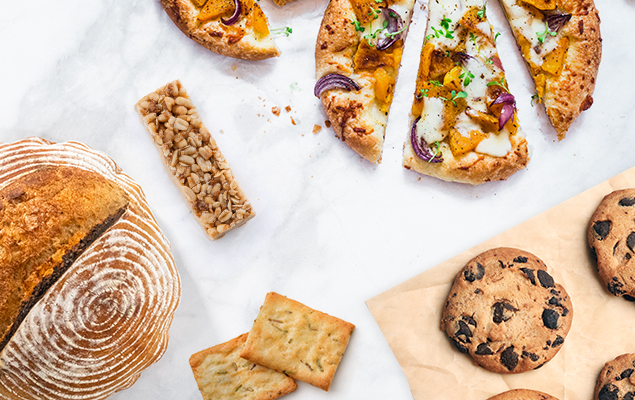Shopping
Finding Balance: Cost-Conscious & Values-Based Shopping

Consumer preferences are ever-changing. And to stay relevant, brands need to be considerate of emerging consumer trends.
At Kemin®, there are three trends we’re focusing on in 2024. Through market research, we’ve seen the proof that these trends are influencing shoppers’ purchasing decisions:
- Cost-Conscious Choices
- Holistic Wellness
- Values-Based Purchasing
With our solutions, we can help you develop baking and snack formulations that balance these trends and appeal to consumers.
Cost-Conscious Choices
Food prices are rising—on both grocery shelves and restaurant menus—and Americans are taking note; 91% of Americans have noticed an overall increase in cost of foods and beverages and 72% describe this increase as “major.”1
So how are consumers coping with the rising prices? They’re learning how to juggle cost and taste. The #1 purchase driver for consumers has always been taste, with 87% stating that it’s their top consideration. But just behind taste is cost, with 76% saying cost is a top consideration when purchasing.1
Consumers are choosing less expensive brands, off-brands, or simply forgoing purchases from their favorite brands—especially if they can find tastes they love somewhere else for a better price.
Sacrifices consumers are willing to make go beyond just brand disloyalty. More than a quarter of consumers, 28%, say they have made less-healthy food and beverage choices due to increased costs.1
Holistic Wellness
Wellness today is more than just eating better or taking the right vitamins. Consumers understand that better nutrition can improve their overall wellness. Food and beverage products can’t just taste good, they also need to help consumers accomplish their wellness goals.
Consumers view wellness across six dimensions: Better Health, Better Fitness, Better Nutrition, Better Appearance, Better Sleep, and Better Mindfulness, and they’re putting their purchasing dollars towards products that attribute to these categories—even if that means upping their budgets. In fact, more than a third of consumers around the world report that they “probably” or “definitely” plan to increase spending over the next year.2
Values-Based Purchasing
Nearly half of U.S. consumers consider themselves value-oriented consumers,3 meaning when purchasing foods and beverages they prioritize larger ideals, such as label claims, ingredient sources, special diets, functional ingredients, and sustainability and social responsibility efforts.
For these consumers, shopping is personal. They’re intentional in where they put their dollars and make sure those purchases reflect their values. Products that are good for people, good for health, good for animals, and good for the planet are what draw in these consumers.
What value-oriented consumers pay attention to:
- Ingredients: 74% always or usually look at ingredients prior to purchasing a product3
- Labels: 75% always or usually pay attention to labels on packaging for food and beverages3
-
Certifications: 73% are influenced by product certifications when purchasing a product3
Source: ©Shutterstock
What These Trends Mean for Manufacturers
To win over today’s consumers, manufacturers need to balance price-conscious consumers with their values-based purchasing behaviors, all while trying to retain margins—which continue to shrink as retailers limit further price increases.
Unfortunately, the majority of CPG brands have lost margins as rising ingredient costs have outpriced pricing increases for the end-consumer. Only 25% of brands have offset cost rises with near equivalent (>81%) price increases.4
Innovative products are the answer to this manufacturing challenge. You need to work with a supplier that provides a complete portfolio of solutions that can help balance consumer demands and drive you toward success.
 Source: ©Shutterstock, ©Adobe Stock and ©Kemin Food Technologies
Source: ©Shutterstock, ©Adobe Stock and ©Kemin Food Technologies
Kemin Can Help
Kemin has the solutions you need to deliver products that solve manufacturing challenges and appeal to today’s consumers. The experts at Kemin can help you overcome today’s cost-in-use challenges and retain margins while delivering high-quality baking and snack products that stay fresher, safer, longer—so you can pass those savings on to the end-consumer.
We’ll help improve and maintain your products’ fresh taste, texture, and appearance as well as keeping them protected from microbial growth. Our extensive portfolio of ingredients will help balance margins and values-based purchasing.
Our Bakery & Snack Solutions
Freshness & Shelf Life
Antioxidants and blends help prevent lipid oxidation in a variety of applications including crackers, biscuits, cookies, and bars.
Mold Inhibition
Mold inhibitors prevent mold growth and prevent resulting spoilage in bakery and tortilla products, while maintaining a desirable texture.
Bakery Blends & Dough Improvers
Enzyme blends, dough conditioners, and batch packs help improve the textural quality and softness of a variety of baked goods.
Check out our Quality Bakery Solutions in 60 seconds video.
Bakery Innovation Center
Our state-of-the-art bakery innovation center and in-house applications team help you solve your baked good and snack challenges. With in-depth knowledge of ingredient functionality, as well as resources that bridge the gap between laboratory scale and commercial production, our team of experts will help elevate your brand to appeal to consumer demands.
At Kemin, we leverage our expertise in formulation and baking & snack know-how to help you create products that stay fresher, safer, longer. We understand and consider consumer buying trends to tailor the ideal solution for your brand that appeals to you and your end-consumer.
Learn more here.
REFERENCES
References:
1 International Food Information Council, 2023 Food & Health survey
2 McKinsey & Company, Feeling good: The future of the $1.5 trillion wellness market, April 8 2021
3 Spins, The Values-Oriented Shopper
4 Wall Street Journal, BCG Pricing Maturity Assessment 2022









